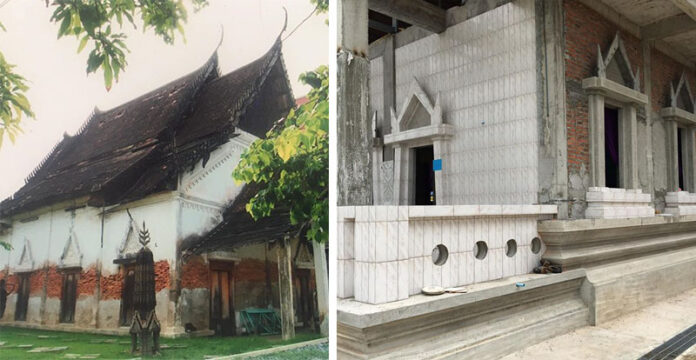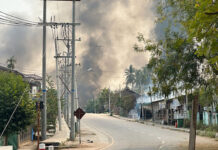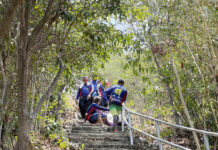
SAMUT PRAKAN — Netizens were left aghast at a “renovation” project that saw a 300-year old Buddhist temple in Samut Prakan refitted with an aluminium roof and floor tiles.
The demolition was so damaging that it stripped Wat Bang Duang Nok of its architectural and historical significance, academic Wara Chanmanee said by phone Tuesday. He said he would file a complaint to the Fine Arts Department about the latest destruction of historic buildings in Thailand.
“It’s such a huge loss. At the very least this temple dated from the late Ayutthaya era. How can you destroy a historical site? It was so beautiful,” Wara said by phone Tuesday. “We all pretend to love historical sites, but when problems happen, everyone says they aren’t responsible.”
Wara visited the temple Monday, and to his horror, found its carved wooden gable dismantled, the floor and walls covered with plain white and faux-marble patterned tiles, and an aluminium roof installed.
“All sense of civilization is destroyed. The temple is rebuilt with lower standards than a rich person’s bathroom. The aluminum roof and mosaics bought from the market give this the same aesthetic as a food court,” Wara wrote in a post Tuesday.
Wara said that Thai historical sites are being razed under a pretense of “renovation” at an exponential rate, pointing to the recent destruction of a colonial-era trading post in Phrae, as well as an old temple in Chaiyaphum painted a shocking pink and orange.
“Most or almost all of the historical sites in our country are being destroyed. When will it stop?” Wara wrote Tuesday on his Facebook. “Will we let stupidity, ignorance, or benefits trump the value of historical places?”
Wat Bang Duang Nok, built during the Ayutthaya era, is an important riverside temple for people travelling by river between Samut Prakan, Bangkok, Pathum Thani and all the way to the Old Capital.
Situated across were warehouses of Dutch traders, and local folklore says Greek adventurer-turned-chancellor Constantine Phaulkon frequented the area.
Wara said he would file a complaint that the temple was destroyed despite being registered as a historical site by the Fine Arts Department. Reconstruction had been attempted before in 2018, but had been halted by the Fine Arts Department, Wara said.
A secretary answering the phone for Fine Arts Department Director Prateep Phengtako said that she would look into the matter.
Related stories:















































